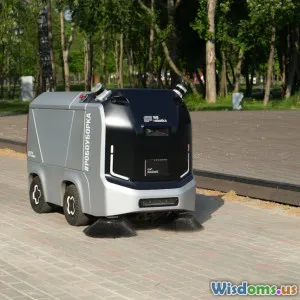
The Rise of Smart Cars: What You Need to Know
9 min read Explore the transformative rise of smart cars and what it means for future mobility. (0 Reviews)
The Rise of Smart Cars: What You Need to Know
Introduction
Imagine a car that not only takes you from A to B but does so intelligently, predicting hazards, optimizing routes, and even self-driving under certain conditions. This vision is rapidly becoming a reality thanks to the rise of "smart cars." As technology permeates every facet of daily life, the automobile industry stands at the forefront of this transformation, integrating artificial intelligence, connectivity, and advanced sensors to redefine mobility.
The surge in demand for more efficient, safer, and environmentally friendly transportation has accelerated the development of smart car technology. Whether through Tesla’s Autopilot, BMW’s ConnectedDrive, or Google's Waymo project, smart cars are no longer science fiction but an emerging staple on our roads.
In this article, we’ll unravel what smart cars are, their core technologies, tangible benefits, the challenges they pose, and what the future holds for us as drivers and passengers.
What Defines a Smart Car?
Smart cars, also known as connected or intelligent vehicles, incorporate an array of digital technologies that allow them to interact seamlessly with drivers, other vehicles, and infrastructure. These vehicles leverage sensors, processors, machine learning algorithms, and communication networks to augment human driving or automate it.
Core Components
-
Sensors and Cameras: Gather real-time data about the vehicle's environment. For example, Tesla's vehicles use an array of cameras, radar, and ultrasonic sensors to enable Autopilot functions.
-
Artificial Intelligence (AI): Processes sensor data to make decisions — from lane-keeping to adaptive cruise control and hazard detection.
-
Connectivity: Through cellular networks and dedicated short-range communications (DSRC), smart cars receive traffic updates, communicate with other cars (V2V), and exchange information with infrastructure (V2I).
-
Human-Machine Interface (HMI): Cars feature interactive touchscreens, voice commands, and heads-up displays to enhance user experience.
Transformational Technologies Powering Smart Cars
Autonomous Driving Levels
The Society of Automotive Engineers (SAE) defined six levels of driving automation, ranging from Level 0 (no automation) to Level 5 (full automation). Currently, many smart cars operate at Level 2 (partial automation), offering features like automated steering and acceleration but requiring full driver attention.
For instance, Tesla’s Autopilot enables highway driving assistance but mandates driver supervision, whereas Waymo aims to deploy Level 4 vehicles capable of operating without human input in limited areas.
Connectivity and Internet of Things (IoT)
Connected smart cars form part of the expanding IoT ecosystem, exchanging data for optimized routing and enhanced safety. Vehicles can alert each other about hazards such as icy patches or accidents ahead, reducing collisions.
A study by the National Highway Traffic Safety Administration (NHTSA) estimates vehicle-to-vehicle communication could reduce certain crashes by up to 80%.
Advanced Driver Assistance Systems (ADAS)
Features like automatic emergency braking, blind spot detection, and pedestrian detection have become standard in many modern vehicles. These systems combine sensor input with AI to intervene before accidents occur.
Electric Powertrain Integration
Smart cars are typically electric or hybrid, combining zero-emission powertrains with intelligent energy management systems. Tesla’s Model 3 exemplifies how software updates can continuously improve performance and efficiency remotely, highlighting smart cars’ unique ability to evolve over time.
Benefits of Smart Cars
Smart cars promise a wide range of advantages over traditional vehicles:
Safety Enhancements
Human error accounts for over 90% of traffic accidents globally. Smart systems can dramatically reduce this through real-time hazard monitoring and emergency interventions. For example, Volvo reports a 20% reduction in crashes with its City Safety system.
Environmental Impact
Optimized driving patterns and electric propulsion decrease fuel consumption and emissions significantly. According to the International Energy Agency, smart electric vehicles play an integral role in achieving global carbon neutrality targets by 2050.
Convenience and Efficiency
Imagine never worrying about parking or traffic jams again. Autonomous valet parking and traffic congestion reduction are already being tested in cities like Phoenix and Singapore. These advancements save time and reduce stress for drivers.
Economic Savings
Though smart cars come with higher upfront costs, potential savings arise from fewer accidents, lower insurance premiums, and decreased fuel expenses. For example, Progressive Insurance offers discounts for vehicles equipped with certain ADAS features.
Challenges and Concerns
Data Privacy
With vast amounts of data being collected on location, behavior, and preferences, protecting user privacy is an ongoing challenge. There have been concerns regarding unauthorized data access or misuse.
Cybersecurity Risks
Connected vehicles are vulnerable to hacking, which could compromise safety-critical systems. Manufacturers must invest heavily in cybersecurity protocols.
Regulatory Hurdles
Laws governing autonomous driving vary widely across regions, slowing down widespread adoption. Policymakers must balance innovation with public safety.
Technological Limitations
Despite significant progress, complete autonomy (SAE Level 5) faces hurdles like unpredictable weather conditions, complex urban environments, and ethical decision-making during unavoidable accidents.
The Road Ahead
The future landscape of smart automobiles is vibrant and rapidly evolving.
Enhanced AI Capabilities
Machine learning algorithms continue to improve, enabling cars to anticipate and adapt more intuitively.
Integration with Smart Cities
Future urban infrastructures will increasingly interact dynamically with smart cars to reduce congestion, manage energy use, and improve emergency responses.
Broader Adoption of Shared Mobility
Smart cars will likely play a crucial role in autonomous ride-sharing services, democratizing access to mobility without the burdens of ownership.
Continuous Software Updates and Upgrades
Similar to smartphones, cars will receive over-the-air software updates to add features and enhance security, maintaining value over time.
As Elon Musk, CEO of Tesla, noted, "Hardware is the easy part, software is the hard part." The ongoing fusion of automotive engineering and software innovation fuels smart cars' unstoppable rise.
Conclusion
The rise of smart cars signals a paradigm shift in how we perceive and experience transportation. These vehicles synthesize cutting-edge technology to deliver safer, cleaner, and more efficient mobility solutions. While challenges surrounding privacy, security, and regulation shouldn’t be overlooked, the benefits position smart cars as pillars of future mobility.
As consumers and society embrace these innovations, staying informed and adaptable will be crucial. Whether you’re a tech enthusiast, policymaker, or everyday driver, understanding smart cars equips you for the exciting journeys ahead.
Are you ready to hit the road with intelligence?
Sources:
- National Highway Traffic Safety Administration (NHTSA) Crash Reduction Data
- Volvo Safety Reports
- International Energy Agency (IEA) Electric Vehicle Outlook
- Tesla Autopilot Technical Publications
- Society of Automotive Engineers (SAE) Automation Levels Documentation
Rate the Post
User Reviews
Popular Posts




















